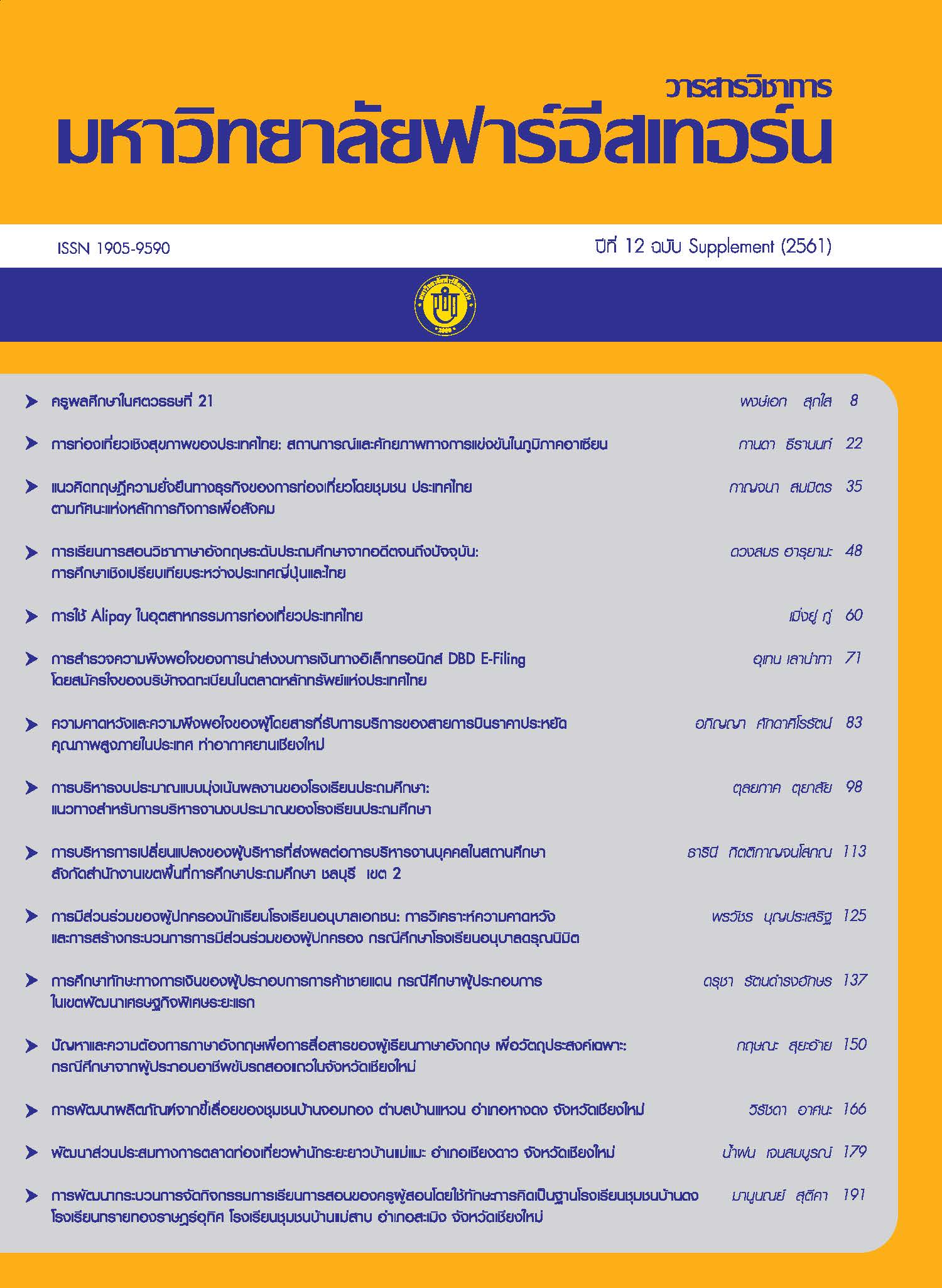Elementary School English Education from the Past up to the Present: A Comparative Study between Japan and Thailand
Main Article Content
Abstract
This study compares the English education in the elementary school level between Japan and Thailand in an overview of history, policy and English teaching and learning in the classroom level. The history of the English education in both countries firstly linked to the colonization around 1800s then gradually bind with globalization which forced both countries to put English as a part of their education systems. The policy level of study, Japan expects the learners to participate in English communication actively, positively and to understand the language and culture of Japan and foreign countries. Whereas, Thailand aims the learners to have a positive attitude towards the language use with the content covered in four C’s: Communication, Culture, Connections and Community. As well, the English teaching and learning, Japan has a Team Teaching (TT)system. Which is comprised of a Japanese homeroom teacher and a native speaker or an Assistant Language Teacher (ALT). They take charge with foreign language activities which focuses on listening and speaking for the 5th and 6th graders. While in Thailand, the Child-Centered and Communicative Language Teaching (CLT) are set as an ideal language learning class from grade one. It gradually focuses on the skills of listening and speaking up to four skills. Both countries share something in common and have some different issues in terms of English education up on the social context. Meanwhile, both countries are trying and working on how to improve all aspects to raise and keep up the English ability of their students.
การศึกษาครั้งนี้เป็นการเปรียบเทียบการศึกษาภาษาอังกฤษในระดับประถมศึกษาระหว่างประเทศญี่ปุ่นและประเทศไทยในภาพรวมของประวัติศาสตร์นโยบายและการเรียนการสอนภาษาอังกฤษในชั้นเรียนประวัติความเป็นมาของการศึกษาภาษาอังกฤษในทั้งสองประเทศนั้น แรกสุดได้มีการเชื่อมโยงกับการล่าอาณานิคมในช่วงศตวรรษที่ 1800-1899 แล้วค่อยๆผูกโยงเข้ากับยุคโลกาภิวัตน์ที่บังคับให้ทั้งสองประเทศบรรจุภาษาอังกฤษเป็นส่วนหนึ่งของระบบการศึกษาในระดับนโยบายญี่ปุ่นคาดหวังว่าผู้เรียนจะมีส่วนร่วมในการสื่อสารภาษาอังกฤษอย่างกระตือรือร้น มีทัศนคติเชิงบวกและเข้าใจภาษาและวัฒนธรรมทั้งของประเทศญี่ปุ่นและประเทศอื่นๆ ในขณะที่ประเทศไทยมีจุดมุ่งหมายให้ผู้เรียนมีทัศนคติที่ดีต่อการใช้ภาษาโดยกำหนดเนื้อหาให้ครอบคลุมถึง 4 ด้านคือ ด้านการสื่อสาร ด้านวัฒนธรรม ด้านการเชื่อมต่อสัมพันธ์ และด้านชุมชนการเรียนการสอนภาษาอังกฤษของประเทศญี่ปุ่นมีระบบการสอนแบบทีม ซึ่งประกอบด้วยครูประจำชั้นชาวญี่ปุ่นและครูเจ้าของภาษาหรือผู้ช่วยครูสอนภาษา ที่รับผิดชอบเกี่ยวกับกิจกรรมภาษาต่างประเทศซึ่งเน้นด้านการฟังและการพูดสำหรับนักเรียนระดับประถม 5 และ 6ขณะที่ในประเทศไทยมีการจัดการเรียนการสอนภาษาที่เน้นเด็กนักเรียนเป็นศูนย์กลาง และการสอนภาษาอังกฤษเพื่อการสื่อสารและระดับชั้นประถมศึกษาปีที่ 1 ถูกจัดให้เป็นระดับชั้นที่เหมาะสำหรับการเริ่มเรียนรู้ภาษาค่อยๆมุ่งเน้นไปที่ทักษะการฟังและการพูดตลอดจนครบถึง 4 ทักษะ การศึกษาภาษาอังกฤษของทั้งสองประเทศมีบางอย่างที่เหมือนกันและมีประเด็นที่แตกต่างกันขึ้นอยู่กับบริบททางสังคม ในขณะเดียวกันทั้งสองประเทศกำลังพยายามหาแนวทางในการพัฒนาทุกๆ ด้านเพื่อยกระดับและรักษาความสามารถภาษาอังกฤษของนักเรียนของตน
Article Details
1. Any views and comments in the Journal of Social Innovation and Lifelong Learning are the authors’ views. The editorial staff have not to agree with those views and it is not considered as the editorial’s responsibility.
2. The responsibility of content and draft check of each article belongs to each author. In case, there is any lawsuit about copyright infringement. It is considered as the authors’ sole responsibility.
3. The article copyright belonging to the authors and The Far Eastern University are copyrighted legally. Republication must be received direct permission from the authors and The Far Eastern University in written form.
References
The Japan Times. Retrieved from https://www.japantimes.co.jp
Brumby, S., & Wada, M. (1990). Team Teaching. Harlow, Essex: Longman
Child-Centred [Def.1]. (n.d.). In Cambridge Dictionary Online, Retrieved August 21, from https://www.dictionary.cambridge.org/dictionary/english/child-centred.
Darasawang, P. (2007) English Language Teaching and Education in Thailand: a decade of change, in D.Prescott (Ed.) English in Southeast Asia: varieties, literacies, and literatures, pp. 187-204. Cambridge: Cambridge Scholar Publishing.
Fujimoto-Adamson, N. (2006) ‘Globalization and and history of English education in Japan’, Asian EFL Journal, 8, 18-35.
Ikegashira A., Matsumoto Y., and Morita Y. (2009). English Education in Japan – From Kindergarten to University. In: Reinelt, R. (Ed.) (2009) Into the Next Decade with (2nd) FL Teaching Rudolf Reinelt Research Laboratory EU Matsuyama, Japan, 16-40.
Kasuya, K., & Kuno, Y. (2010). Elementary School English Education in Japan: Its history and the sound of its teaching materials. Retrieved from https://www.gavo.t.utokyo.ac.jp/L2WS2010/papers/L2WS2010_S-04.pdf
Khanarat S., & Nomura T. (2008) The analysis of English teaching methods as the second language in Thailand and Japan. J. Saitama Univ. Fac. Edu., 57829:91-103 (2008)
Methitham, P., & Chamcharatsri, P. B. (2011). Critiquing ELT in Thailand: A reflection from history to practice. Journal of Humanities, Naresuan University, 8(2), 57-68
Ministry of Education, 2008. The Basic Education Core Curriculum B.E. 2551 (A.D. 2008). Retrieved from https://www.act.ac.th/document/1741.pdf
Ministry of Education, Culture, Sports, Science, and Technology (MEXT). (2017) Chapter 4 Foreign Language Activities. Retrieved from https://www.mext.go.jp/component/english/__icsFiles/afieldfile/2011/03/17/1303755_011.pdf
Nishida H. (2006). Elementary English Education -The Present Condition of the Japanese Education System- 外国語教育フォーラム第5号. Retrieved from https://www.kansai-u.ac.jp/fl/publication/pdf_forum/5/081nishida.pdf
Richard, J.C. & Farell, T.S.C. (2005) Professional development for language teacher: Strategies for teacher learning. Cambridge University Press.
Richards, J.C. & Rodgers, T. S. (2001). Approaches and methods in language teaching (2nd ed.). Cambridge, UK: Cambridge University Press.
Sermsongswad U., & Tanipongsamuruk C. (2013) Chapter 1.5 English Language Education in Thailand. Retrieved from https://bruneiusprogramme.org/wp-content/uploads/2013-Forum-Publication-Complete.47-52.pdf
Shimizu, M. (2010). “Japanese English education and learning: A history of adapting foreign cultures.” Educational Perspectives, v43 n1-2 p5-11 2010
Takasaki Polish (2017) 独自のプログラムで英語に親しむ高崎市の子供たち Monthly Magazine Takasaki Polish, 7(236), 6-7

